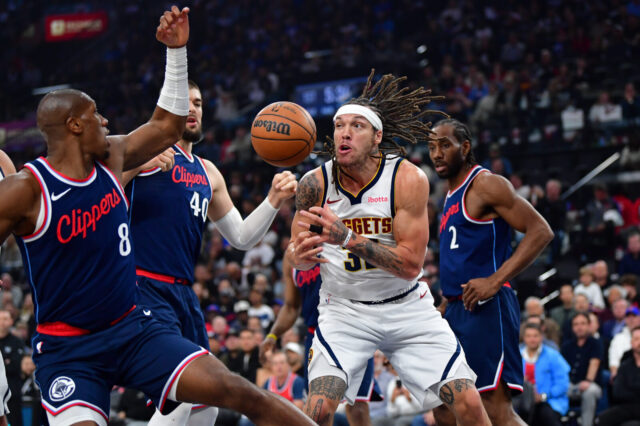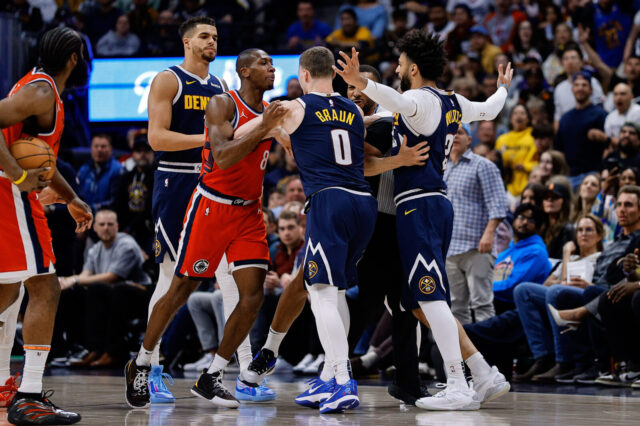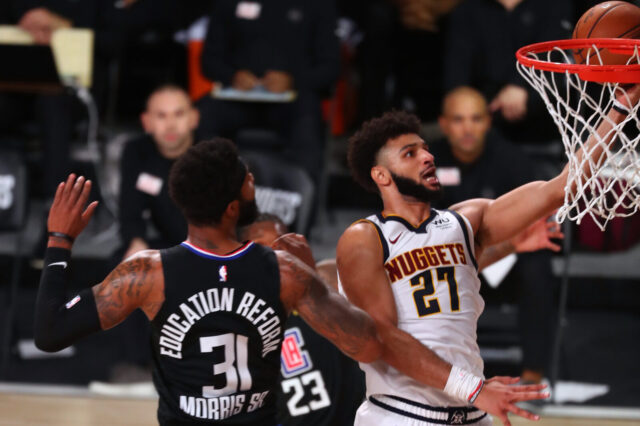While the majority of the conversation around the Denver Nuggets and their involvement in the four-team trade that sent Malik Beasley and Juancho Hernangomez to the Minnesota Timberwolves, there were elements of this deal that have been overlooked by fans.
Most notably, the players the Nuggets received in the deal.
Coming from the Timberwolves are three players who played mostly bench roles this season. Denver will actually receive four players in the trade, but Houston Rockets wing Gerald Green has been dealing with a serious injury, and according to Mile High Sports’ own TJ McBride, Green will be waived upon completion of the deal.
So, that reduces the total down to Houston’s first round pick in 2020 and the three players Denver acquired from Minnesota: Shabazz Napier, Noah Vonleh, and Keita Bates-Diop. Let’s talk about each of them.
Shabazz Napier – Point Guard, 6-foot-0, 175 pounds
Per Game Stats: 36 games, 23.8 minutes, 9.6 points, 5.2 assists, 3.1 rebounds, 1.1 steals
Shooting Stats: 40.3 Field Goal % — 29.6 Three-Point % — 81.8 Free Throw %
Advanced Metrics: 53.9 True Shooting, 2.46 Assist:Turnover, -1.2 Box Plus-Minus, +0.34 Real Plus-Minus
Breakdown: Shabazz Napier is a smaller point guard with good quickness off the dribble. He can break down most defenses in the pick and roll and makes good decisions with the basketball. He started 22 games for the Timberwolves, averaging 11.4 points and 6.1 assists per game as a starter while shooting 34.0% from three. In his minutes as a reserve, Napier struggled greatly, especially without Karl-Anthony Towns on the floor.
Napier’s size limits him on both ends. Opposing point guards don’t fear him, but he’s very sneaky on both sides. He averages 1.1 steals in his 23.8 minutes, and his 2.2% steal rate would be the best on the Nuggets roster by a thin margin over Jamal Murray and Gary Harris. Despite that size, he has shot well at the rim this year with the spaced floor of the Timberwolves’ five-out system.
Here’s Napier’s scoring play type breakdown via Second Spectrum stats:
This content is no longer available.
Napier gets most of his work done in the pick and roll and is relatively efficient. He relied on spacing with Karl-Anthony Towns during many of his pick and rolls, so the bump up with Nikola Jokic may not happen. The former Minnesota guard was efficient in spot up situations but horrid in dribble handoffs and coming off screens.
Expected Role: I wouldn’t expect Napier to play over Monte Morris. Denver’s current backup point guard has found his rhythm in recent weeks. During Denver’s last 15 games, Morris has averaged 10.5 points, 4.5 assists, and just 0.8 turnovers per game (a 5.58 AST:TOV) while shooting 45.7% from the field and 36.4% from three. In addition, Morris is slightly taller and can at least bother more players defensively. Unless another move is made, I wouldn’t expect Napier to be in the post All-Star rotation.
Noah Vonleh – Power Forward/Center, 6-foot-10, 257 pounds
Per Game Stats: 29 games, 12.0 minutes, 4.1 points, 0.9 assists, 4.0 rebounds
Shooting Stats: 54.7 Field Goal % — 14.3 Three-Point % — 82.1 Free Throw %
Advanced Metrics: 60.5 True Shooting, 1.37 Assist:Turnover, -0.9 Box Plus-Minus, -0.93 Real Plus-Minus
Breakdown: Noah Vonleh is a big man that can play power forward or center depending on the lineup with specialties in rebounding and efficient shooting around the rim. With a 17.4% rebounding rate, Vonleh actually rates higher than Nikola Jokic grabbing boards. He has strong rebounding rates on both ends of the floor and is impactful that way.
The interior scoring is good too, with some of his positive production coming out of the post. He’s best as an offensive rebounder though and very efficient while he does it.
Here’s Vonleh’s scoring play type breakdown via Second Spectrum stats:
This content is no longer available.
Surprisingly, that interior scoring hasn’t translated out of the pick and roll, but Vonleh did share the floor with a Minnesota team that doesn’t run a lot of pick and roll. Denver doesn’t either with their starters, but they do on the second unit, so Vonleh might not be a bad option for Mason Plumlee in a pinch. Vonleh’s jumper also disappeared this season after showing signs of improvement while with the New York Knicks in 2018-19.
Either way, Vonleh is a limited contributor on the offensive end. His problem will always be defense. He doesn’t see the floor exceptionally well, and he’s not generally large enough to be a rim protector with just six total blocks in his 347 minutes of action this year. It remains to be seen if he could operate as a back line defender or at the level of the ball screen in Denver’s aggressive scheme. He will have to pick it up quickly if Denver’s defense isn’t to fall apart with him on the floor.
Expected Role: Don’t expect Vonleh to play much when Denver gets back to full strength. Mason Plumlee is a better option for everything Denver wants to do, and Vonleh is simply more limited in what he can do on both sides of the ball. Despite that, I’d expect Vonleh to get minutes with Denver as soon as Saturday night. The Nuggets could use a big man to fill in while Paul Millsap and Mason Plumlee continue to recover from injuries.
Keita Bates-Diop – Small Forward/Power Forward, 6-foot-8, 229 pounds
Per Game Stats: 37 games, 17.5 minutes, 6.8 points, 0.8 assists, 3.0 rebounds
Shooting Stats: 42.2 Field Goal % — 33.0 Three-Point % — 70.8 Free Throw %
Advanced Metrics: 53.5 True Shooting, 2.14 Assist:Turnover, -2.3 Box Plus-Minus, -2.96 Real Plus-Minus
Breakdown: Keita Bates-Diop is a long and strong forward in his second season out of Ohio State. He was a four-year college player and a second round pick in the 2018 draft. Our own Daniel Lewis wrote a draft profile on him about 18 months ago, and he came away with the similar impressions to what Bates-Diop has shown so far. Bates-Diop has the physical build to be a forward in the NBA, but his skill level and top end athleticism is suspect.
In Minnesota’s system, Bates-Diop was rarely trusted with the ball in his hands. There were many mouths to feed with Towns, Andrew Wiggins, Jeff Teague, Jarrett Culver, and others in and out of Minnesota’s rotation. That has led to him becoming primarily a spot up shooter.
Here’s Bates-Diop’s scoring play type breakdown via Second Spectrum stats:
This content is no longer available.
As can be seen, Bates-Diop used most of his possessions shooting spot up jumpers, though he had the skill level to do some other things. He was really solid as a cutter on a reasonably high volume of possessions, he was efficient on put backs, and he ran the occasional handoff action to success. Unfortunately, Bates-Diop was never going to look great in Minnesota as only a spot up shooter, because shooting appears to be his biggest weakness right now. He has skills to do other things.
Defensively, the impact just wasn’t there in Minnesota. Perhaps he looks better on a roster with better defensive players in Denver, and he has the body type Denver needs going forward. At 6’8 and thick enough to battle with some of the bigger All-Stars in the NBA, it would be wise of Denver to cultivate his talent. He’s not OG Anunoby, but he has a similar frame with a 7-foot-3 wingspan. That can help mask a lot of weaknesses if he can be in the right position.
Expected Role: As with Napier and Vonleh, don’t expect Bates-Diop to play immediately. He has many players in front of him, including Michael Porter Jr., that are more deserving of time. Unlike Napier and Vonleh though, I could see Bates-Diop having a role in Denver’s rotation as soon as next year. Both Paul Millsap and Jerami Grant are on expiring contracts, as is Mason Plumlee. Bates-Diop could be groomed for a backup forward role next season if Porter steps into a starting role. Bates-Diop just turned 24, and his contract is a non-guaranteed deal in 2020-21 for very cheap. With Denver’s roster getting expensive quickly, having cheap deals to balance things out will keep Denver flexible going forward.
Well, there they are. The new additions to Denver’s roster. None of the players pop off the screen like Michael Porter Jr. or Malik Beasley from an offensive perspective, but they don’t have to for the rest of this season. The Nuggets likely know their rotation and are going with it. I like Bates-Diop as a complementary option when Porter sits. He’s a good cutter with good size, something Michael Malone and Nikola Jokic will notice and potentially use in future years. Just because he doesn’t play now doesn’t mean he can’t play in the future.
If there are more moves made and one of the above guys is moved, then so be it. At least you learned something new.


